Railfan's Guide to Altoona

Hollidaysburg
Updated April 10, 2017
Hollidaysburg Canal Basin
"Hollidaysburg was a small backwoods village in the early 1820s. Founded in the years after the Revolution, the settlement's growth was hampered by its location in the rugged remoteness of the Allegheny foothills. The Huntingdon, Cambria, and Indiana Turnpike, a narrow dirt road really, ran through the heart of town, bringing an occasional pack train of horses or a Conestoga wagon. Its population in 1827 was about 76. This all changed with the coming of the Pennsylvania Canal. Within ten years, Hollidaysburg had a population of 3,000 -- and growing. From a tiny frontier village to an inland seaport -- this all took place within a five-year period. And it all happened because a farmer wouldn't sell his land to the Pennsylvania Canal Commission. When the Commonwealth of Pennsylvania began letting contracts for the building of the state's canal system, work commenced on the two ends of the canal and progressed steadily toward the middle. No one was sure how they were going to lift canal boats over the Allegheny Ridge until the two divisions of the waterway were within just a few miles of the mountains. After abandoning the idea of digging a four-mile tunnel through the mountains, the Allegheny Portage Railroad was accepted as the best method for getting the boats across the mountains. Once this course was set, it was necessary to find good locations for two canal basins -- one on the eastern side of the ridge to take the boats out of the canal and one on the western side to refloat them. The western basin location was easy. The little town of Johnstown was at the confluence of the Stony Creek and Little Conemaugh rivers, which supposedly would ensure an adequate water supply for the basin.
On the eastern side, it was determined that the hamlet of Frankstown would be the ideal location for the second basin. However, the site selected by the canal engineers was located on the property of a farmer who either didn't like the idea of change or who was a little too greedy to accept the price he was offered for his land. In any event, the canal engineers turned elsewhere, finally determining that Hollidaysburg was an acceptable alternative. Moreover, the site had the highest elevation that could possibly be used to construct the basin.
And so it began. Hundreds of workers were recruited from the surrounding countryside and from distant cities to begin digging the canal and cutting the stone for related structures. Their arrival alone mushroomed the population of the little town. It is hard to imagine how they accomplished the task before them. There were no steam shovels, bulldozers, or even electricity to allow them to work through the night. Instead, there were merely men and their muscles --with a little help from wheelbarrows and horse-drawn wagons to haul away the excavated dirt. When they were done, a gigantic artificial pool emerged from the bottomland along three branches of the Juniata River converging nearby. The water for these streams had their sources among the rocks and trees of the mountains in the distance. The main basin itself was six feet deep, 120 feet wide, and two miles long. There were actually three interconnected basins in the port complex. The main basin was located where railroad yards are now. This was connected by a 600-foot canal segment to a smaller basin located just below present-day Juniata Street. The third pool was really a feeder reservoir for the other two. It was located near the modern intersection of Route 22 and Allegheny Street in Hollidaysburg. Once the basins were filled with water, Hollidaysburg's transformation into a seaport was only a matter of time. At its height, the canal brought a boat into the port every 20 minutes. Boat slips and docks were built to handle the freight streaming into the area. Large warehouses and freight forwarding houses were erected near the docks. Hotels and taverns catering to boatmen and travelers arose among the modest houses in the town. At first, canal boats were unloaded on the Hollidaysburg wharves, their freight and passengers transferred to railcars for the trip across the mountains on the Portage Railroad. A later innovation, the three- or four-section canal boat, could be hauled out of the water, disassembled, and placed on "trucks," small metal-wheeled undercarriages that ran on rails. After completing their journey over the mountains, the section boats were reassembled at the Johnstown canal basin and continued on their watery way. The large freighters made frequent appearances in paintings from the time. However, the passenger packets appeared most frequently in books and essays. Their human cargo preserved the canal saga in words.
Philip Nicklin made a cross-state journey in 1835 that provided the subject matter for "A Pleasant Peregrination Through the Prettiest Parts of Pennsylvania, Performed by Peregrine Prolix." This is how Nicklin described Hollidaysburg at the time: "Hallidaysburg [sic] has the air of a new clearing, and looks so unfinished, that one might suppose it to have been built within a year. Its site is good, rising gradually from the basin to a pleasant elevation. Many substantial buildings are going up, and it is evident that rapid increase is the destiny of the town." While passenger traffic made up a good deal of the business flowing through Hollidaysburg, manufactured goods contributed to the bulk of trade. Pianos, flour, cement, nails, and everything in between traveled on canal freighters. There were also a number of boats converted into floating stores. The owners of these establishments sent riders ahead to announce the imminent arrival of the boats. Although Hollidaysburg housewives firmly believed they were getting great bargains on the merchandise sold from the boats, the town's storekeepers were less than enthusiastic. Written accounts from the canal period mention the "unfair advantage" the floating stores had at the expense of Hollidaysburg's business proprietors. Along with the commercial bustle near the basin, small iron foundries and machine shops made their appearance in back alleys in Hollidaysburg and Gaysport, the area just to the south and across the Beaver Dam branch of the Juniata River. Here, implements and tools were fabricated from pig iron produced in furnaces in the surrounding hills. One of these fledgling companies, the McLanahan Corporation, continues in operation today. Tens of thousands of people passed through Hollidaysburg during the canal era. European immigrants, native-born Americans, '49ers during the Gold Rush -- they all made their way westward via the canal or the rough turnpikes crisscrossing the mountains. By the late 1850s, it became apparent that the canal system was obsolete. In 1857, the Pennsylvania Canal was bought by the Pennsylvania Railroad. Shortly thereafter, the Allegheny Portage Railroad was dismantled and the Hollidaysburg basin's days were numbered. A photo from 1863 shows the basin still in use, although boat traffic is nearly absent. The boat slips, warehouses, and wharves are nearly deserted.
However, the basin continued in operation until about 1875, mostly serving the needs of area farmers and manufacturers. One of the frequent floods along the Juniata destroyed much of the infrastructure associated with the canal in this part of Pennsylvania. Repairs were too expensive and plans were made to abandon the section between Hollidaysburg and Huntingdon, some 30 miles east of the basin. After this portion of the canal was finally closed, the great inland port was drained of water and the massive basin was filled in with cinders, probably the by-product of the iron furnaces surrounding Hollidaysburg. A way of life for hundreds of people for 50 years came to an end." (National Park Service)
History of Lakemont Park
"Opened in 1894 as a trolley park, Lakemont Park has overcome many obstacles to become the 8th oldest amusement park in the United States. One of Lakemont's most prized possessions is the world's oldest roller coaster, Leap-the-Dips. Built at the park in 1902 by the E. Joy Morris Company, the historic wooden roller coaster was restored and reopened on memorial Day 1999. It was named a National Historic Landmark in 1996." Lakemont Park & Island WaterPark
Hollidaysburg and Petersburg Branch Overview
For further information see the PRR Middle Division: Hollidaysburg & Petersburg Branch and Railfan Pennsylvania - Altoona East Railfan Guide.
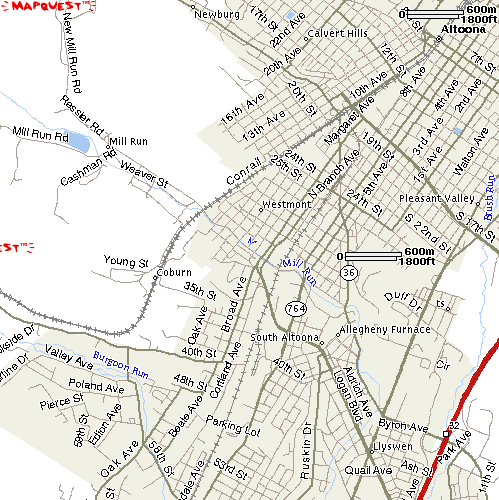
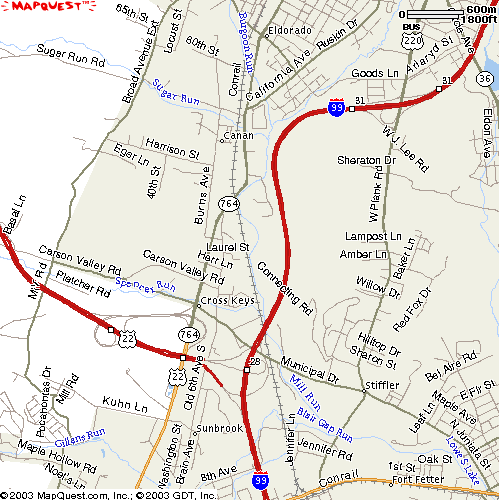
Duncansville - Wye Switches
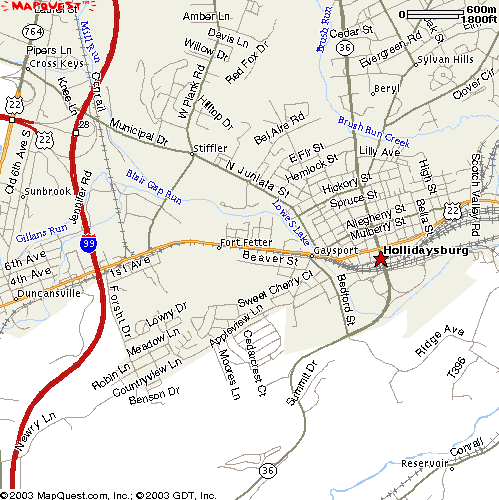
 |
Wye Switches. View towards Duncansville. Date XXX. Photo by Chris Behe | Wye Switches. View towards Hollidaysburg. Date XXX. Photo by Chris Behe |
|
Cove Secondary |
|
Hollidaysburg, PA
Hollidaysburg Overview
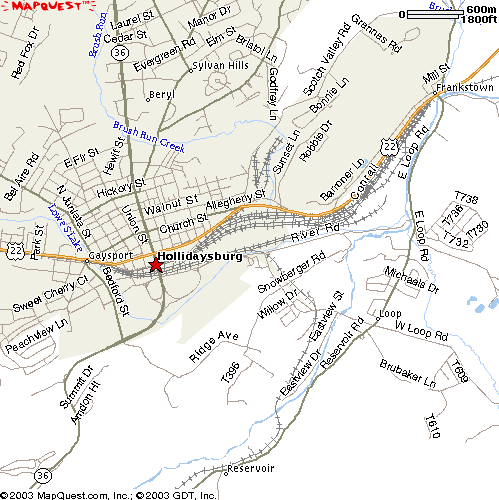
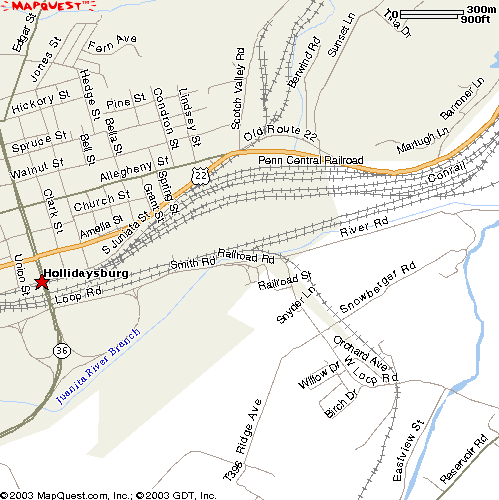
Hollidaysburg Track Chart
History of the Hollidaysburg
Car Shops
by Jim Logrando - Norfolk Southern Mechanical Department, Altoona, PA
In 1949, the PRR began studies with the goal of weatherproofing repairs to freight cars. It was known at the time that it was cost effective to get as much car repair work as possible under roof so that operations were no longer subject to interruptions caused by rain and cold weather. At the same time, railroad management decided that a production line type car repair setup might be established if there were sufficient facilities for accumulating cars of the same type in large numbers. Successful production line operations require a steady flow of work into the shop.
The site at Hollidaysburg was selected because the former classification yard in the area provided sufficient space for the huge plant that was planned. This site was located on a PRR line at Hollidaysburg that parallels the main line, but bypasses the Horseshoe Curve and Altoona. In the early 1950's there was little movement over this route, except for rare instances when the main line was blocked for some reason. In the 20's and 30's, this bypass was regularly used by some through freights, and Hollidaysburg had a hump classification yard and a large locomotive terminal. Use of these facilities had ended many years ago and by 1950, the Hollidaysburg buildings and yards were either abandoned or used only for storage.
PRR officials planned for parts of the old classification yard to be used to provide track space necessary for accumulating cars in sufficient numbers to support production-line type repairs. The site required a minimum of grading and had a close proximity to the Altoona area shops and the planned Reclamation Plant in Hollidaysburg permitted combining all cars repair operations into one complex.
In June 1952, the PRR directors authorized construction of the new car shop, named the Samuel Rea Car Shop in honor of former PRR President and Hollidaysburg native Samuel Rea. Construction began in October 1952, when removal of the hump was started. Production in the newly completed Samuel Rea Shop began on a limited basis in 1955, full scale operations beginning in 1956.
|
Penn Central 1974 - The Movie
From Steve Lubetkin's blog where he writes: ""This is the movie commissioned by the Penn Central Railroad bankruptcy trustees to try to convince members of Congress that the railroad desperately needed a cash infusion or some other federal intervention if the railroad were to survive. Think of it as the social media of its day, a corporate movie commissioned as a way of educating elected officials who had little time or inclination to actually visit the railroad to find out what was going on. In fairness, there are some anecdotes I've heard about the making of this movie, including the fact that some of the really bad conditions just wouldn't cooperate with the filmmakers. So instead of showing actual "standing derailments" (derailments caused by crossties so rotted that the rails just spread apart under the weight of the freight cars), they actually had to stage some of them. There is a scene of a car derailing as it moves down the "hump" track in a classification yard, and I'm told it took more than one take to get it to derail. Despite these moviemaker tricks, the facts were pretty bleak for Penn Central. And the movie did help convince Congress to do the only right thing. Take control of the company and the other bankrupt railroads, and make something new. Conrail. And considering what the car companies are asking for as an INTERIM solution for just the next three months ($15 billion), Conrail was a bargain at $7.6 billion -- all in.
|
When completed, the 2,760 foot long main shop was 180 feet wide with approximately three miles of railroad track installed under 704,472 square feet of roof. Along the North side were two large bays used for truck and wheel work. The main shop and these two truck bays were floored throughout with six inches of concrete.
Shop offices, a tool room, a cafeteria and locker rooms were built along the North wall of the building. Much of the South side of the building was used for storage. These included two warehouse buildings covering over 30,000 square feet and equipped with covered unloading docks. An additional outside storage area of about 800 feet long served by two overhead cranes.
East of the shop is a scale for light-weighing cars after they are rebuilt. This scale was part of the equipment used in the old Hollidaysburg Classification Yard. It was renovated and lengthened before being installed at the Samuel Rea Shop. North of the main shop building was another service building containing two oil (or gas) fired boilers and two 3,000 CFM synchronized - motor driven air compressors. Locker rooms, offices, cafeteria and some smaller work areas were heated with steam-fed space heaters. The boiler plant also heated hot water for the locker rooms. The repair areas of the main shop were not heated.
Car Repair Operations Layout at the Samuel Rea Shop
In 1955, the shop production floor layout at the time of opening of the Samuel Rea Shop called for car repair operations over three tracks that ran the full 7,760 feet length of the building. A fourth full length track at the South side of the building was designated for material handling, but could be used for production if the need arose. Maximum flexibility was built into the three production tracks, so that they could be tooled to make repairs on any type of freight car.
It was possible that all three lines could be repairing the same class of car at the same time. It was equally possible that each line might be doing a different type of car. Along the entire length of the tracks were key-slots in the concrete floor for use in erecting PRR designed portable scaffolding as the need arose. This scaffolding could be quickly set up or dismantled to accommodate changes in the production schedule.
Service boxes were provided on each side of the track on 40 feet centers throughout the shop. This permitted the use of short hoses, short welding cables and short electric lines. The idea here was to leave the shop floor area as open as possible for the movement of material handling trucks.
After incoming cars were cut down and made ready for rebuilding, they were transferred from their own trucks to temporary shop trucks. The road trucks then moved to the first two truck areas for dismantling. Wheels were cleaned and moved to the wheel and axle shop. Side frames and other truck parts were then built up, annealed and transferred to the truck assembly area. Here the reconditioned wheel and axle sets and the rebuilt truck components were then assembled and moved back to the main production line. In the meantime, the car body had been rebuilt and inspected. Rebuilding included grit blasting of the original car body surface to remove rust and old paint. A fresh coat of new paint was then applied on-line in the paint shop.
The freshly painted rebuilt car body then was reapplied to a set of rebuilt road trucks. The temporary shop trucks that carried the car through the assembly, cleaning and painting operations moved to the beginning of the production line for reuse. The car was stenciled while still in the car shop and then moved out onto the scale for light-weighing and shipment for railroad service.
Car movement down the production line was accomplished by floor-mounted winches which had the capacity to move up to four cars at one time. Twenty-four of these winches were installed along the three production tracks. Material was moved to the production lines by shop trucks and overhead cranes which spanned every bay. These overhead cranes were also used for some production operations.
When fully operational in 1956, the Samuel Rea Car Shop was capable of producing 50 cars per day based on a two-shift operation of each of the production tracks. Third shift activities were denoted to cleaning up and restocking the production line for the next day's operations.
The Samuel Rea Shop was renamed the Hollidaysburg Car Shop by Conrail and this name continues on under now Norfolk Southern management. Much of the operation of the shop remained the same as described above except that the fourth track was a full time production track and car repairs/rebuilding are done for other railroads on a commercial contract basis as well as for Norfolk Southern's own fleet. The Hollidaysburg Car Shop employed about 500 employees.
NS Sells Hollidaysburg Car Shops to Co. Development Corp.
First publish date: 03-25-2006
Author: TO News from NSNorfolk Southern Railway Company and Pennsylvania's Blair County Development Corporation III (BCDC), a subsidiary of the Altoona-Blair County Development Corporation, today announced that they have entered into a tentative agreement to transfer ownership of the Hollidaysburg Car Shop from NSRC to BCDC.
D Holdings Inc., an affiliate of the DeGol Organization, will serve as the initial industrial occupant, primary tenant, and principal private financer and developer for the entire project. This agreement is subject to BCDC satisfactorily completing comprehensive title, subdivision and environmental reviews, which are expected to take several months.
"While there is still a lot of work to be done to conclude this transaction, we are pleased that we are making significant progress," said Wick Moorman, Norfolk Southern's chief executive officer. "The staffs of the Altoona-Blair County Development Corporation and the DeGol Organization should be commended for their efforts. Congressman Bill Shuster and Pennsylvania Senator Pro Tem Bob Jubelier also deserve recognition for their guidance and support."
"By working together, Norfolk Southern and Blair County have come up with an agreement that should benefit both sides," said Congressman Bill Shuster, chairman of the Economic Development Subcommittee in the U.S. Congress. "In order for our economy to continue making progress there needs to be cooperation like this, and now Blair County Development Corporation has added a tremendous asset, which is likely to create jobs and build upon an important and unique landmark in Hollidaysburg."
"There has been a tremendous, concentrated effort poured into finding the right prospect to transform the car shops property. The sales agreement is a huge step forward. A property that has for several years stood vacant as a relic of our industrial past can again become an economic engine for jobs and opportunity in the future," Senator Robert C. Jubelier said. "Both the relentless nature of the search by local economic development leaders and the cooperation of Norfolk Southern were needed to make this magical moment possible."
"Altoona-Blair County Development Corporation, in cooperation with its affiliated organizations, Blair County Development Corporation III and the Blair County Industrial Development Authority, is pleased to serve as both a facilitator and coordinator in the initiation and advancement of this major Blair County project," said Martin J. Marasco, president and chief executive officer of ABCD Corp. "The transition of the Hollidaysburg Car Shop property from a major manufacturing facility of the past century into a breeding ground of new knowledge-based, high value assembly and advanced manufacturing for the 21st Century will be both a challenging and exciting opportunity. ABCD Corp. commends the DeGol family on their vision and willingness to work shoulder-to-shoulder with other community partners to turn their vision into reality and transform an underutilized dormant property into a vibrant regional asset."
The execution of the agreement of sale marks the initial stage of a multi-phased strategy that will result in the redevelopment of the Hollidaysburg Car Shop property into a mixed use/commercial/industrial/open space complex that will foster investment, reinvestment and the creation of expanded job opportunities. The transaction includes the main car shop building, the reclamation plant, as well as approximately 330 acres of land in Frankstown Township and the Borough of Hollidaysburg. Financial terms of the transaction were not disclosed.
Named in honor of former Pennsylvania Railroad president and Hollidaysburg native Samuel Rea, the shop was opened by the PRR in 1955 to build and maintain the railroad's car fleet. The shop was renamed the Hollidaysburg Car Shop by Conrail, and operations ceased in July, 2002.
Redevelopment of Former Hollidaysburg Car Shops
Via Railpace.com Hot News:
Pennsylvania Governor Edward G. Rendell today announced Pennsylvania's investment of $2 million to breathe new life into the former Norfolk Southern Rail Car Shop in Hollidaysburg, Blair County, and create more than 100 new jobs. The state funds will support the purchase and redevelopment of the property so it can be turned into a mixed-use, commercial/industrial/open space complex. "Throughout Pennsylvania, we continue to make investments that are helping our communities attract new jobs and new businesses," Governor Rendell said. "By breathing new life into former industrial sites, and helping to develop shovel-ready locations, we are making sure we can meet the needs of companies looking to grow and expand while creating new opportunities for our working men and women. "This project is an excellent example of how our innovative $2.8 billion economic stimulus plan works. Small communities, like Hollidaysburg, have fewer resources to devote to development of business locations. With our investment, we can help towns and cities with projects like this one that bolster our business-friendly reputation and encourage business expansion." The state's funding is provided through the Redevelopment Assistance Capital Program (RACP). The initial phase of the project is estimated at $4 million, including the purchase price and facility improvements. D Holdings Inc. and two other affiliates of the DeGol Organization will serve as the initial industrial occupant, primary tenant and principal private developer for the entire project. As part of the phase II redevelopment of the 750,000-square-foot building, manufacturers Seven D Truss and D Shapes and Doors will occupy a large portion of the existing building, resulting in the expansion of their Pennsylvania manufacturing operations, preservation of existing jobs and creation of new job opportunities. Subsequent phases include ongoing predevelopment and concept planning to maximize and diversify utilization of the balance of the property. "The acquisition and redevelopment of the Hollidaysburg car shops has been identified as a regional priority investment and critical to the future of the economic growth of the Altoona, Blair County, area, the I-99 Innovation Regional Corridor and the southern Alleghenies region," said Martin J. Marasco, president and CEO of ABCD Corp. "In addition to functioning as a 'hub' for manufacturing and warehousing operations, the complex, once fully developed, will enhance initiatives to implement emerging and innovative programs and projects for new knowledge-based firms considering relocating, expanding or starting up in our area." The commonwealth also supported this project by awarding a $175,000 Business in Our Sites Planning Grant to ABCD Corp. in December 2004. The funds were used for an engineering feasibility study, an environmental investigation, mapping, wetland delineation, concept plan development, storm water management design and an infrastructure improvement plan. The Redevelopment Assistance Capital Program is a commonwealth grant program administered by the Office of the Budget for the acquisition and construction of regional economic, cultural, civic and historical improvement projects. Since February 2003, Governor Rendell has issued a total of $733 million in RACP grants for 258 projects. (Pennsylvania Office of the Governor - posted 3/24)
References:
Railway Age Magazine. October 31, 1955.
For additional information, see the Conrail Cyclopedia - Car Shops: Hollidaysburg, PA Interior Photos Web Page.
PRR Morrison's Cove, PA Branch
The Horseshoe Curve Chapter, National Railway Historical Society, has operated several excursions this summer and autumn (July-October 2000) on the former PRR secondary branch, The Morrison's Cove branch. These trips have been operated with the cooperation of the Everett Railroad Company and the Roaring Spring (PA) Historical Society, utilizing power and crews from the Everett RR, chapter owned ex-Lackawanna RR commuter coaches (3) and participation of Chapter members as car attendants. It's been a very rewarding experience for us all and a chance for area residents and visitors to enjoy the countryside between Hollidaysburg-Roaring Spring-Martinsburg. The crown jewel is the finely restored PRR passenger station in Roaring Spring, owned and operated by the Roaring Spring Historical Society.
The Morrison's Cove Branch is still quite active today under the auspices of the Everett Railroad Company, and presently terminates within the two villages (via a wye) Martinsburg, Pa., and Curryville, Pa., primarily farming/agricultural communities. However, at one time in the early part of the prior century, the line terminated in the village of Henrietta in southern Blair County, also a very rural area. Passenger service was provided between Henrietta and Altoona known as the Henrietta Accommodation.
Interestingly, information contained in the publication "Blair County's Postal History and McGraw's Blair County Place Names" published by the Blair County Historical Society in 1947, contains the following:
Henrietta Post Office
" At the completion of the Morrison's Cove Branch of the Pennsylvania Railroad, of which Henrietta was the southern terminal, the post office was established at that place April 4, 1872, with Daniel D. Morrell, manager of the Cambria Iron Company's interests, as the post master.
Mr. Morrell served the people of Henrietta faithfully for a score of years until he was succeeded by J. Elvin Hagey on the 16th of Fegruary, 1898. The only compensation he received was what he realized from the cancellation of stamps. His average salary amounted to about $4.00 a month during the early years of his postmastership. The following persons succeeded Mr. Hagey on the dates given and in the order stated:
Chas. A. Brumbaugh..Apr. 3, 1914
Jno. H. Endsley (Act) Mch 6, 1928
Seyphert F. Dunn Oct 16, 1914
Jno. H. Endsley July 3, 1928
Frank H. Teeters Oct 8, 1919
Maud Nicodemus June 14, 1934
The office was discontinued January 15, 1935, and the community served by rural delivery from Martinsburg. During the years when the ore mines were in operation, the office served about 350 persons." (by David Seidel; posted 9/23/00)
See Robert Schoenberg's Pennsy Page for the October 1925 Issue of "The PRR Information" magazine for a Profile of Samuel Rae.

NRHS and its logo are trademarks of the National Railway Historical Society
Photos are by Chris Behe unless otherwise noted.
Revised April 2017